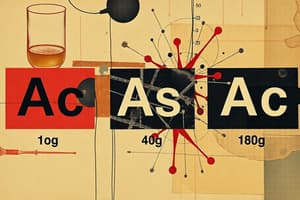Podcast
Questions and Answers
ما أصغر وحدة في العنصر؟
ما أصغر وحدة في العنصر؟
الذرة
ما هو الفرق بين المزيج غير المتجانس والمزيج المتجانس؟
ما هو الفرق بين المزيج غير المتجانس والمزيج المتجانس؟
يمكن فصل مكونات المزيج غير المتجانس، بينما لا يمكن فصل مكونات المزيج المتجانس.
ماذا تُشير الخاصية الفيزيائية للمادة؟
ماذا تُشير الخاصية الفيزيائية للمادة؟
تُشير إلى خصائص المادة التي يمكن ملاحظتها دون تغيير تركيبها الكيميائي.
ما هي الخاصة الكيميائية للمادة؟
ما هي الخاصة الكيميائية للمادة؟
ماذا يُشير المصطلح اللزوجة؟
ماذا يُشير المصطلح اللزوجة؟
ما الفرق بين النظائر؟
ما الفرق بين النظائر؟
من هو العالم الذي صاغ مصطلح ذرة؟
من هو العالم الذي صاغ مصطلح ذرة؟
ماذا يُشير نموذج بودنغ البرقوق للذرة؟
ماذا يُشير نموذج بودنغ البرقوق للذرة؟
ما الذي توصل إليه إرنست رذرفورد عن الذرة؟
ما الذي توصل إليه إرنست رذرفورد عن الذرة؟
من صاغ نموذج الكواكب للذرة؟
من صاغ نموذج الكواكب للذرة؟
من وضع نموذج الكم للذرة؟
من وضع نموذج الكم للذرة؟
ما هو الخليط؟
ما هو الخليط؟
ما هي أشهر أساليب تسمية المركبات التساهمية؟
ما هي أشهر أساليب تسمية المركبات التساهمية؟
ما هو المول؟
ما هو المول؟
ما هي الكتلة المولية؟
ما هي الكتلة المولية؟
ما هي أهم العناصر المكونة للجزيئات الحيوية؟
ما هي أهم العناصر المكونة للجزيئات الحيوية؟
ما هي عملية التنفس الخلوي؟
ما هي عملية التنفس الخلوي؟
ما هي وظيفة الريبوسوم؟
ما هي وظيفة الريبوسوم؟
ما هي وظيفة الغشاء الخلوي؟
ما هي وظيفة الغشاء الخلوي؟
ما هي وظيفة الميتوكوندريا؟
ما هي وظيفة الميتوكوندريا؟
ما هو الانقسام المتساوي؟
ما هو الانقسام المتساوي؟
ما هو الانقسام الاختزالي؟
ما هو الانقسام الاختزالي؟
ما هي الأجزاء الرئيسية للزهرة الكاملة؟
ما هي الأجزاء الرئيسية للزهرة الكاملة؟
ما هي الصفات السائدة؟
ما هي الصفات السائدة؟
ما هي الصفات المتنحية؟
ما هي الصفات المتنحية؟
ما هو مبدأ التماثل؟
ما هو مبدأ التماثل؟
ما هي خطوات الانقسام المتساوي بالترتيب؟
ما هي خطوات الانقسام المتساوي بالترتيب؟
Flashcards
الذرة
الذرة
أصغر وحدة من عنصر ما
المزيج غير المتجانس
المزيج غير المتجانس
مزيج يمكن فصل مكوناته
المزيج المتجانس
المزيج المتجانس
مزيج لا يمكن فصل مكوناته
الخاصية الفيزيائية
الخاصية الفيزيائية
Signup and view all the flashcards
الخاصية الكيميائية
الخاصية الكيميائية
Signup and view all the flashcards
الخاصية المكثفة
الخاصية المكثفة
Signup and view all the flashcards
الخاصية الواسعة
الخاصية الواسعة
Signup and view all the flashcards
اللزوجة
اللزوجة
Signup and view all the flashcards
النظائر
النظائر
Signup and view all the flashcards
نموذج بودينغ البرقوق
نموذج بودينغ البرقوق
Signup and view all the flashcards
نظرية ديمقريطس
نظرية ديمقريطس
Signup and view all the flashcards
نموذج رذرفورد
نموذج رذرفورد
Signup and view all the flashcards
نموذج بور
نموذج بور
Signup and view all the flashcards
النموذج الكمومي
النموذج الكمومي
Signup and view all the flashcards
المزيج
المزيج
Signup and view all the flashcards
المول
المول
Signup and view all the flashcards
الكتلة المولية
الكتلة المولية
Signup and view all the flashcards
الجزيئات الحيوية
الجزيئات الحيوية
Signup and view all the flashcards
التنفس الخلوي
التنفس الخلوي
Signup and view all the flashcards
تخليق البروتين
تخليق البروتين
Signup and view all the flashcards
غشاء الخلية
غشاء الخلية
Signup and view all the flashcards
دورة كريبس
دورة كريبس
Signup and view all the flashcards
الانقسام المتساوي
الانقسام المتساوي
Signup and view all the flashcards
الانقسام المنصف
الانقسام المنصف
Signup and view all the flashcards
الزهور الكاملة
الزهور الكاملة
Signup and view all the flashcards
الزهور غير الكاملة
الزهور غير الكاملة
Signup and view all the flashcards
الجين
الجين
Signup and view all the flashcards
الجين السائد
الجين السائد
Signup and view all the flashcards
الجين المتنحي
الجين المتنحي
Signup and view all the flashcards
قانون الانفصال
قانون الانفصال
Signup and view all the flashcards
التكافل
التكافل
Signup and view all the flashcards
التطفل
التطفل
Signup and view all the flashcards
التعايش
التعايش
Signup and view all the flashcards
Study Notes
Science
- Atom: Smallest unit of an element
- Heterogeneous mixture: Mixture whose components can be separated
- Homogeneous mixture: Mixture whose components cannot be separated
- Physical property: Changes that can be observed without changing the substance (color, melting/boiling point)
- Chemical property: Changes observed after a chemical reaction (flammability)
- Intensive property: Doesn't depend on the amount of matter (density, temperature, color)
- Extensive property: Depends on the amount of matter (mass, volume, moles)
- Viscosity: Resistance of a liquid to flow (e.g., honey)
- Isotopes: Elements with the same number of protons but different mass numbers
Atomic Theories
- Democritus (500 BC): Proposed that all matter is composed of indivisible particles
- John Dalton (1803): Introduced the concept of the atom, visualized as a solid sphere.
- J.J. Thompson (1904): Developed the Plum Pudding model, where negatively charged particles are embedded in a positively charged sphere.
- Ernest Rutherford (1911): Proposed the Nuclear model, with a small, dense, positively charged nucleus containing most of the mass.
- Niels Bohr (1913): Proposed the Planetary model, where electrons orbit the nucleus in specific energy levels
- Erwin Schrödinger (1926): Developed the Quantum model, describing electrons as existing in probability clouds (orbitals) rather than fixed paths.
Mixtures
- Mixture: A combination of two or more substances that retain their individual properties.
- Covalent compounds: Naming convention for covalent compounds: "Add ide to the end of the second element, use mono-, di-, tri-, etc. to indicate the number of each element."
- Examples: (e.g. mono-di-, tri-, tetra-, penta-)
Moles and Molar Mass
- Mole: A unit representing 6.022 x 1023 elementary units of a substance.
- Molar mass: The mass of one mole of a substance (in grams)
- For atoms, the molar mass is numerically equal to its atomic mass.
- For molecules, it is the sum of the atomic masses of all atoms in the molecule.
- Example: Water (H2O): 18.015 grams per mole
Biomolecules
- Biomolecules: Essential for life, combinations of Carbon, Hydrogen, Oxygen, Nitrogen, Phosphorus, Sulfur ("CHONPS").
Cellular Respiration, Cell Division, and Flowers
- Cellular Respiration: Process where cells convert glucose into ATP
- Protein Synthesis: Ribosome function in cells.
- Cell Membrane: Regulates the movement of substances into and out of the cell.
- Mitochondria: Site of the Krebs cycle; known as the powerhouse of the cell.
- Mitosis: Cell division in non-reproductive cells, producing two identical daughter cells.
- Meiosis: Cell division in reproductive cells (sperm/egg), producing four daughter cells (haploid).
- Flowers: Categories of flowers include perfect (having male and female parts), imperfect (having one type of reproductive part), complete (having all flower parts), and incomplete (lacking some flower parts).
Mendelian Genetics
- Allele: Different versions of a DNA sequence.
- Dominant Allele: Determines the organism's characteristics.
- Recessive Allele: Characteristic is masked when a dominant allele is present.
- Law of Segregation: Each organism has two alleles for each gene, which separate during meiosis.
- Steps of Mitosis Detailed stages of Mitosis (PPMAT: Prophase, Prometaphase, Metaphase, Anaphase, Telophase, Cytokinesis).
Animal Relationships; Transpiration
- Animal Relationships: Predation (one organism eats another), parasitism (one benefits at the expense of the other), mutualism (both benefit), and commensalism (one benefits, the other is unaffected)
- Transpiration: Plants move water from roots to leaves
Other Topics (Pages 3, 4)
- DNA: Genetic material
- Insulin: Hormone that regulates blood glucose
- Scalar Quantities: Described by magnitude only
- Vector Quantities: Described by magnitude and direction.
- Thermodynamics: Zeroth, First, Second, and Third Laws (explaining thermal equilibrium, energy transformation, entropy, and the relationship to absolute zero)
- Archimedes' Principle: Describes the buoyant force on a submerged object.
- Waves: Disturbances that travel and carry energy. (Mechanical and Electromagnetic waves, wave properties).
Other Topics (Pages 5-9)
- Geological Time Scale: Overview of Earth's history, periods, and eras.
- Discourse: A form of communication like writing or speaking used for analysis or discussion. Types included: persuasion (to convince), description, exposition, narration, etc. Discourse types are found in academic, business, and artistic contexts
- Kinds of Nonverbal Communication: Examples such as paralanguage, gestures, facial expressions, etc.
- Elements of Communication: Including the sender, message, encoding, channel, decoding and receiver, and feedback
- Fallacies: Logical errors in arguments (Ad Hominem, Ad Verecundiam, Bandwagon, etc).
- Wave Phenomena: Reflection, refraction, diffraction, and interference.
- Types of Rocks: Igneous (intrusive/extrusive), Metamorphic (foliated/non-foliated), Sedimentary (classic/chemical/organic)
- Literary Discourse: Types of discourse in literature or essays (primarily transactional, poetic, and expressive).
- Specific Fallacies: (e.g., Accent, Amphiboly, Complex Question, Equivocation, etc.)
Studying That Suits You
Use AI to generate personalized quizzes and flashcards to suit your learning preferences.
Related Documents
Description
اختبر معرفتك بأساسيات علم الكيمياء من خلال هذا الاختبار. ستشمل الأسئلة حول الذرات، الخواص الفيزيائية والكيميائية، وأنواع الخلطات. اكتشف المزيد عن التواريخ والنظريات الحيوية التي شكلت فهمنا للعالم الذري.




